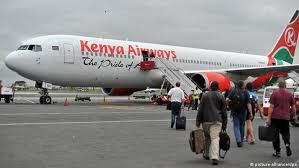Kenya Airways has called on African airlines to stop seeing themselves as competitors and start working together to boost revenues and grow the aviation industry across the continent. The airline said better collaboration can help reduce operating costs and make flying more affordable for passengers in Africa.
The Chief Executive Officer of Kenya Airways, Allan Kilavuka, made this appeal while addressing journalists in Nairobi, Kenya’s capital city, on Monday. He explained that African carriers are still too small when compared with global aviation giants, and working together will help them become stronger and more profitable.
Kilavuka revealed that Kenya Airways has already launched a new platform known as the Pan-African Airline Group. According to him, this platform was created to encourage joint efforts among African airlines. He said the airline has also started informal talks with other local and regional carriers who are interested in forming partnerships and even merging to reduce the high costs of running airlines.
“The size of African airlines is very small. When compared to airlines from Europe, America, or Asia, most African carriers operate with limited fleets and struggle with profitability,” Kilavuka said. “That is why we need to consolidate. Let’s stop fighting each other and focus on building alliances that can help us grow.”
He explained that a major issue in the African aviation sector is the fragmentation of the air transport market. Many airlines operate independently within narrow airspaces, making it hard for them to cut costs, increase flight frequencies, or expand to new markets. This, in turn, raises airfares and discourages more people from flying.
Kilavuka also mentioned that in the past, some parts of the continent had regional airlines that helped to bridge the gap. He pointed to examples in East and West Africa where regional carriers used to connect several countries. He said that if airlines across the continent can come together like before, it will bring back the benefits of those regional operations and help reduce the cost of air travel for everyone.
According to him, strategic partnerships will also allow airlines to combine resources such as maintenance facilities, training programs, flight scheduling, and fuel supply. He believes that when airlines share services and infrastructure, it can help bring down the unit cost of operations. This means that for every passenger carried, the airline spends less money, which improves profit margins and allows room for lower ticket prices.
Kilavuka said the high cost of air travel is a big challenge across Africa and a major reason why many Africans still prefer road transport, despite the risks and longer travel times. He insisted that it is time for African airlines to change this narrative by working together to offer more affordable and accessible flight options.
He also noted that cooperation does not always mean mergers. Airlines can form codeshare agreements, alliances, or joint ventures that allow them to benefit from shared routes, common ticketing systems, and better passenger experiences. He said Kenya Airways is ready to lead in this direction and is open to working with any interested carrier across Africa.
Industry experts believe that if airlines cooperate more, they can attract larger investment, compete better with foreign carriers operating in Africa, and help African economies grow through improved trade and tourism.
At present, most African airlines face similar problems, including high operating costs, limited access to spare parts, poor funding, and strict aviation regulations. Many also deal with issues related to aircraft leasing, fuel importation, and low passenger traffic. Kilavuka believes that addressing these problems together, instead of individually, will lead to better results.
He urged governments across Africa to support the idea of airline cooperation and create policies that encourage integration, rather than isolation. He said that with the right policies and partnerships, Africa’s aviation sector can grow to its full potential and become a major driver of economic development.
